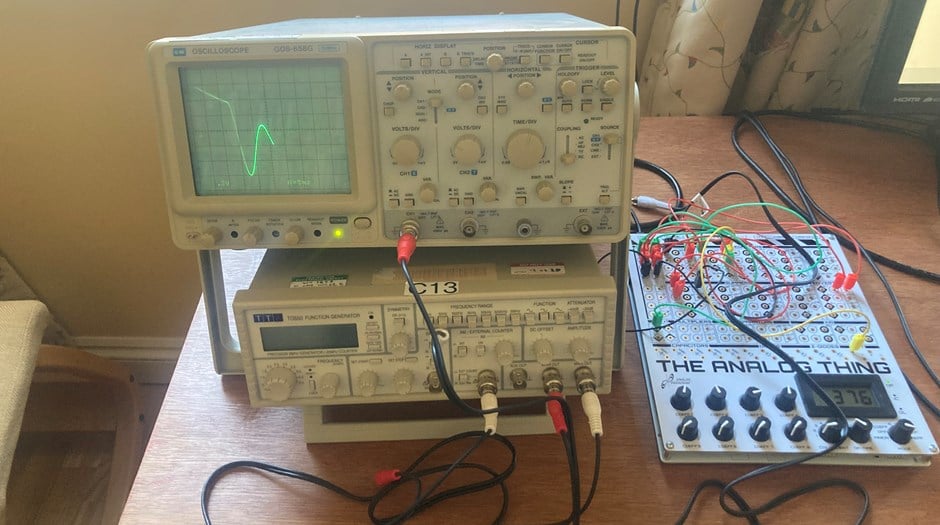26 May 2023
Forget quantum computing, the future lies with analog!

Thanks to Pete Dring's recent giveaway of unwanted school electronics equipment, I now have an analog oscilloscope, and function generator, which have allowed me to get my brand new analog computer up and running. The picture shows my analog computer 'programmed' (wired up) to simulate a simplified car suspension system (one mass, one spring, one damper) responding to a bump in the road.
The analog computer (called THAT - The Analog Thing) was released around the start of this year, designed by Dr Bernd Ulmann, possibly the world's foremost authority on (historical and modern) analog computing. The headline of this blog is a quotation from Bernd, who believes that analog computing will make a comeback! Many people are under the impression that the electronic analog computer was killed off by the emergence of the electronic digital computer. In fact, though, the electronic analog computer wasn't invented until after the electronic digital computer! And the two co-existed until the early 1970s - because they played different roles. Digital computing works better for finding quantitive answers to problems; analog computing works better for finding qualitative answers, which is of considerable interest to scientists and engineers. Digital computers only displaced analog computers in the 1970s when they became powerful enough to emulate an analog computer. Specifically:
- Fast enough to run a simulation in real time, with live interaction (changing of variables) by the user
- Had high resolution graphical displays that could show curves and waveforms in detail, like an oscilloscope does
- Supported 'qualitative' user inputs, for example by means of a mouse or touch-screen, (or the more recent concept of 'swipe' and similar gestures)
So why does Bernd think they could make a comeback?
1. There is still very much a need for qualitative computing - for example in simulatons, or live control. (Quantum computing will, for many years yet, be restricted to this sort of application)
2. Analog computers can run at very low power - micro Watts. Bernd envisages medical computing devices that could be powered via a thermocouple from your body heat. Digital computing is inherently power-hungry because every single digtial flip between two stable states (billions of them per second) necessarily involves hysterisis. Thing of an ordinary lightswitch: it takes effort to switch it in either direction to overcome the spring: if there was no spring, the light would switch on/off frequently with the slightest vibration or changes in air pressure. A solid state digital switch necessarily has the same principle.
3. Analog computers aren't susceptable to viruses, or system crashes (there's no Alt-Ctr-Del buttons on an analog computer!)
Bernd's THAT device is designed for educational use, not industrial application. It uses state of the art electronic technology. At its heart are lots of 'op-amps' 'operational amplifiers'. If you've every done any hobbyist electronics, you've doubtless used an op-amp - probably the ubiquitous '741' - a tiny integrated circuit. But did you know why an op-amp is so called? (After all there wouldn't be an obvious market for a 'non-operational amplifier'!) The answer is that the 'operational' bit doesn't mean 'working': instead it refers to mathematical operations. The op-amp was first designed to be used in analog computing: to provide mathematical operations such as addition (or 'summing'), comparison (conditions), subtraction, a very limited form of multiplication, and, especially, integration.
The integration is important because analog computers are primarily used to solve non-linear differential equations - which typically cannot be solved using calculus.
The machine generally regarded as the first general-purpose digital electronic computer, the ENIAC, which went live just after the end of WWII was also designed for exactly the same purpose. The name stood for Electronic Numerical Integrator And Computer (my italics). But the ENIAC didn't displace electronic analog computers (the latter hadn't been invented yet, remember). The ENIAC was designed to be a faster, more flexible version, of the mechanical analpog computer, specifically the Differential Analyzer (DA), invented by Vannevar Bush. Both the DA and the ENIAC were applied primarily to the calculation of ballistic trajectories for large naval guns (which do not follow a simple parabola).
Vannevar Bush, however, believed that the contribution of his DA (and this holds true for electronic analog computers, too) was more than simply allowing more complex calculation to be done more quickly. He believed that it had an important educational value also: that by wiring up the components (integrators, summers etc) to model a differential equation, you actually gained a far more intuitive understanding of what differential equations really are. If any of your pupils go on to do any type of engineering degree (as I did) they had better learn to love differential equations - they will be spending a lot of time with them. Next time they think of replacing their laptop, perhaps they should be thinking about 'upgrading' to an analog one ;-)


Discussion
Please login to post a comment